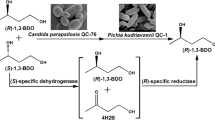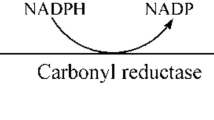Abstract
(S)-N-Boc-3-hydroxypiperidine (S-NBHP) is a critical chiral intermediate in the synthesis of pharmaceuticals, including ibrutinib, the active pharmaceutical ingredient of the new drug Imbruvica approved for the treatment of lymphoma. An (R)-specific carbonyl reductase from Candida parapsilosis (CprCR, also known as R-specific alcohol dehydrogenase) that catalyzes asymmetric reduction to produce (S)-N-Boc-3-hydroxypiperidine (S-NBHP) was identified for the first time. When co-expressed with a glucose dehydrogenase from Bacillus megaterium in Escherichia coli Rosetta (DE3), recombinant crude enzyme exhibited an activity of 9 U/mg with N-Boc-3-piperidone as the substrate and 12 U/mg with glucose as the substrate. The biocatalysis of N-Boc-3-piperidone to S-NBHP using recombinant whole-cell biocatalysts was processed in a water/butyl acetate system as well as an aqueous monophasic system without extra NAD+/NADH. This process showed great commercial potential, with a 100 g/l substrate concentration and a whole cells loading (w/v) of 10%, with the conversion of 97.8% and an e.e. of 99.8% in an aqueous monophasic system.
Graphical Abstract













Similar content being viewed by others
References
Advani RH, Buggy JJ, Sharman JP, Smith SM et al (2013) Bruton tyrosine kinase inhibitor ibrutinib (PCI-32765) has significant activity in patients with relapsed/refractory B-Cell malignancies. J Clin Oncol 31:88–94
Bradford MM, McRorie RA, Williams WL (1976) A role for esterases in the fertilization process. J Exp zool 197:297–301
Chakraborty AA, Phadke RP, Chaudhary FA, Shete PS et al (2005) Optimization of redox reactions employing whole cell biocatalysis. World J Microbiol Biotechnol 21:221–227
Danielsson O, Atrian S, Luque T, Hjelmqvist L et al (1994) Fundamental molecular differences between alcohol-dehydrogenase classes. Proc Natl Acad Sci USA 91:4980–4984
Dragutan I, Dragutan V, Demonceau A (2012) Targeted drugs by olefin metathesis: piperidine-based iminosugars. Rsc Adv 2:719–736
Goldberg K, Schroer K, Luetz S, Liese A (2007) Biocatalytic ketone reduction - a powerful tool for the production of chiral alcohols—part I: processes with isolated enzymes. Appl Microbiol Biotechnol 76:237–248
Gröger H, Hummel W, Rollmann C, Chamouleau F et al (2004) Preparative asymmetric reduction of ketones in a biphasic medium with an (S)-alcohol dehydrogenase under in situ-cofactor-recycling with a formate dehydrogenase. Tetrahedron 60:633–640
Hellberg LH, Beeson C, Somanathan R (1986) Synthesis of the spirocyclic alkaloid nitramine. Tetrahedron Lett 27:3955–3956
Honigberg LA, Smith AM, Sirisawad M, Verner E et al (2010) The Bruton tyrosine kinase inhibitor PCI-32765 blocks B-cell activation and is efficacious in models of autoimmune disease and B-cell malignancy. Proc Natl Acad Sci USA 107:13075–13080
Iyer PV, Ananthanarayan L (2008) Enzyme stability and stabilization—aqueous and non-aqueous environment. Process Biochem 43:1019–1032
Jain N, O’Brien S (2015) Targeted therapies for CLL: Practical issues with the changing treatment paradigm. Blood Rev 30:233–244
Jornvall H, Hoog JO, Persson B (1999) SDR and MDR: completed genome sequences show these protein families to be large, of old origin, and of complex nature. Febs Lett 445:261–264
Kim JH, Thart H, Stevens JF (1996) Alkaloids of some Asian Sedum species. Phytochemistry 41:1319–1324
Kizaki N, Yasohara Y, Hasegawa J, Wada M et al (2001) Synthesis of optically pure ethyl (S)-4-chloro-3-hydroxybutanoate by Escherichia coli transformant cells coexpressing the carbonyl reductase and glucose dehydrogenase genes. Appl Microbiol Biotechnol 55:590–595
Lacheretz R, Pardo DG, Cossy J (2009) Daucus carota mediated-reduction of cyclic 3-Oxo-amines. Org Lett 11:1245–1248
Laemmli UK (1970) Cleavage of structural proteins during the assembly of the head of bacteriophage T4. Nature 227:680–685
Lineweaver H, Burk D (1934) The determination of enzyme dissociation constants. J Am Chem Soc 56:658–666
Liu YC, Liu Y, Wu ZL (2015) Synthesis of enantiopure glycidol derivatives via a one-pot two-step enzymatic cascade. Org Biomol Chem 13:2146–2152
Makrides SC (1996) Strategies for achieving high-level expression of genes in Escherichia coli. Microbiol Rev 60:512–538
Müller P, Bangasser BL, Greiner L, Na’Amnieh S et al (2011) Stable continuous operation of a biphasic enantioselective enzymatic reduction. Open Catal J 4:113–116
Musa MM, Phillips RS (2011) Recent advances in alcohol dehydrogenase-catalyzed asymmetric production of hydrophobic alcohols. Catalscitechnol 1:1311–1323
Nie Y, Xu Y, Wang HY, Xu N et al (2009) Complementary selectivity to (S)-1-phenyl-1,2-ethanediol-forming Candida parapsilosis by expressing its carbonyl reductase in Escherichia coli for (R)-specific reduction of 2-hydroxyacetophenone. Biocatal Biotrans 26:210–219
Reid MF, Fewson CA (1994) Molecular characterization of microbial alcohol dehydrogenases. Crit Rev Microbiol 20:13–56
Shah N, Hutchinson C, Rule S (2014) Ibrutinib for the treatment of mantle cell lymphoma. Expert Rev Hematol 7:521–531
Shen W, Shen Z, Hu Z, Lin Y et al (2013) Synthesis of (S)-1-Boc-3-hydroxypiperidine. Chin J Pharm 44:436–438
Snider BB, Cartayamarin CP (1984) Total synthesis of (+/−)-nitramine—development of a ketene equivalent in the ene reaction. J Org Chem 49:1688–1691
Tanaka N, Kusakabe Y, Ito K, Yoshimoto T et al (2003) Crystal structure of glutathione-independent formaldehyde dehydrogenase. Chem Biol Interact 143:211–218
Thieblemont C (2015) Ibrutinib: a new drug of B-cell malignancies. Bull Du Cancer 102:S85–S90
Xu GP, Wang HB, Wu ZL (2016) Efficient bioreductive production of (S)-N-Boc-3-hydroxypiperidine using ketoreductase ChKRED03. Process Biochem 51:881–885
Ye Q, Cao H, Zang G, Mi L et al (2010) Biocatalytic synthesis of (S)-4-chloro-3-hydroxybutanoate ethyl ester using a recombinant whole-cell catalyst. Appl Microbiol Biotechnol 88:1277–1285
Ye Q, Ouyang P, Ying H (2011) A review-biosynthesis of optically pure ethyl (S)-4-chloro-3-hydroxybutanoate ester: recent advances and future perspectives. Appl Microbiol Biotechnol 89:513–522
Zhu W, Wang B, Wu H, Li B (2015) A Chemo-enzyme method to synthesis of (S)-t-butyl 3-hydroxypiperidine-1-carboxylate. Chin J Pharm 46:349–350
Funding
This research did not receive any specific grant from funding agencies in the public, commercial, or not-for-profit sectors.
Author information
Authors and Affiliations
Corresponding author
Rights and permissions
About this article
Cite this article
Chen, J., Yan, M. & Xu, L. Efficient synthesis of (S)-N-Boc-3-hydroxypiperidine using an (R)-specific carbonyl reductase from Candida parapsilosis . World J Microbiol Biotechnol 33, 61 (2017). https://doi.org/10.1007/s11274-016-2189-y
Received:
Accepted:
Published:
DOI: https://doi.org/10.1007/s11274-016-2189-y




